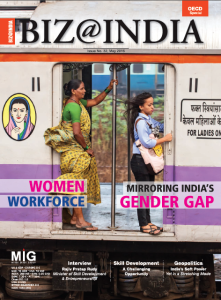India becomes a $2 trillion dollars economy
Biz@India
The acceleration of growth in the 4th quarter – January-March, at 7.9% has powered the Indian economy that has crossed the symbolic mark of a 2 trillion dollars economy, at INR exchange rate of around 67 dollars. On the whole, in 2015-2016, India grew at 7.6%, boosted by this last leg acceleration. But challenges persist, notably in a still weak rural economy and in a fragile international context that could weight on the external demand.
So far, the forecast are good in terms of monsoon and the salary hikes in the government sector, under the Seventh Pay Commission’s recommendations, should boost the domestic demand. Private consumption grew at 7.4% in 2015-2016. But private investment remains weak and the economy still faces challenges.
Experts from international organisations such as the International Monetary Fund (IMF), the World Bank, or from a prominent credit rating agency like Moody’s, anticipate a gradual acceleration of the Indian economy in the coming years. But they always do it using two types of notable precautions.
The dependence on the external environment
As a first precaution, they factor a good international environment on which India still heavily depends on. For instance, India has been taking advantage recently of some low commodity prices, such as oil and gas. It has a positive effect on its current account balance and gives the government some room for manoeuvre, in terms of public spending. It allows India for example, to decrease the level of fuel subsidies more easily, to reduce its deficit or allocate the money in some other area.
But this positive environment will not last forever as commodity prices are cyclical by nature. Because of low price levels, oil and gas production capacities and investments have already started reducing in countries such as the United States, preparing the ground for an inevitable rebound of the oil market. The only questions are: when will the rebound happen and how big will it be.
Also, regarding the international context, so far India has limited its exposure to external problems like the Chinese economic slowdown. But in a world economy highly interdependent and instable (political crisis in Syria, Ukraine and so on), where engines of growth are very weak (Europe, Japan) or fragile (US, China), a scenario similar to the one that occurred after the 2008 world financial crisis could well happen again – a slowdown in India because of a financial crisis and a lack of demand outside ; and because of persistent inner weaknesses, which prevent the country to fully rely on an internal engine of growth, at least as a temporary relay.
Bank clean up and elevated corporate debt
India, thanks to the Reserve Bank of India’s sound policy has a much more stable currency, less inflation and a far better reputation amongst international financial investors than in the past. Hence it has a reduced exposure to a currency crisis that was one its most dreaded risks in the recent past, up until the last one in 2013. There is still the second notable precaution taken by economic observers though – they warn against the negative factors that are still in place in the Indian economy on both the investment level and the demand level. On the investment side, Moody’s underlines for instance, the persistent need for banks’ balance sheet repair and points at an ‘elevated corporate debt.’ RBI is on the same line, trying continuously to clean up the banking system and to open it to new sectors, to increase its level of competition and to make the financial system less accident prone.
Rural issues: droughts and price volatility
On the demand side, even if interest rates are on a downward path, there is a persistent pressure on consumers, particularly from rural areas, because of food price inflation and droughts. The Indian economy has improved for sure and is looked at positively from abroad but ultimately it needs to expand its internal engine of growth. In a country with a population still mostly living in rural areas, that must be done by continuously addressing key questions such as a better access to credit facilities for farmers and more stability in agricultural prices. With a stronger domestic market, India will then become less vulnerable to an erratic international economic environment.

Read more about Indian Economy and India and the BRICS in our Biz@India OECD Special Issue 2016. Buy the e-magazine here.










